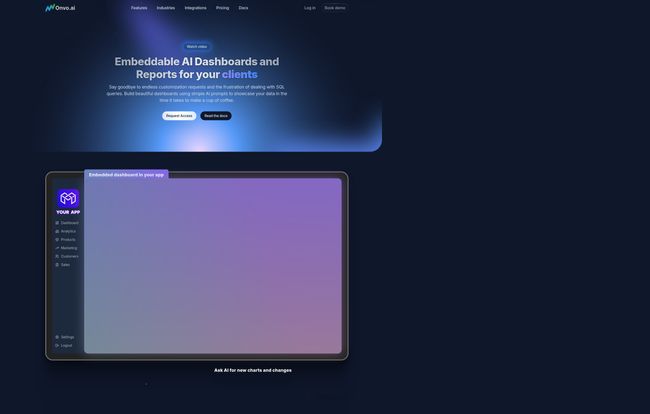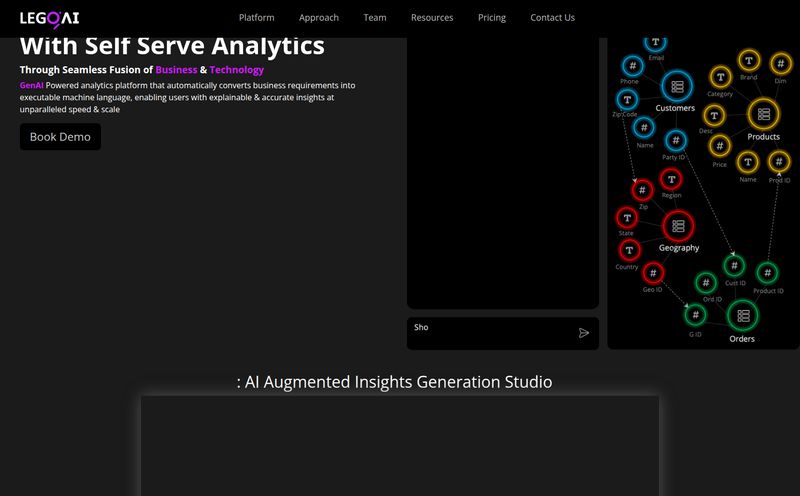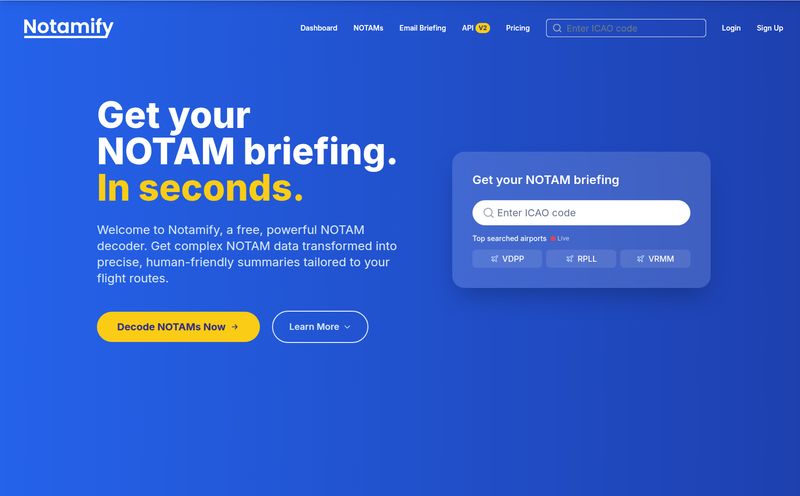I’ve been in the SEO and data game for a long, long time. Long enough to remember when building a customer-facing dashboard meant a six-month project, a small army of back-end developers, and enough SQL queries to make your eyes bleed. We’d spend weeks wrestling with clunky BI tools, trying to make a bar chart that didn’t look like it was designed in 1998. The whole process was, to put it mildly, a massive pain.
So, whenever a new tool pops up promising to make it all “easy” and “instant,” my inner cynic just rolls his eyes. We’ve heard it all before, right? But then I stumbled upon Onvo AI, and I have to admit, my curiosity got the better of me. A platform that lets you build and embed complex, beautiful dashboards just by… asking for them? In plain English? Okay, you have my attention.
So, What is Onvo AI, Really?
Let’s cut through the marketing jargon. Onvo AI is an AI-powered platform designed to help developers and businesses create data dashboards and reports. The big hook, the main event, is its use of natural language prompts. Instead of writing SELECT COUNT(user_id) FROM users WHERE signup_date > '2024-01-01' GROUP BY country;, you’re supposed to be able to just type, “Show me new user signups by country this year.”
It’s built for embedding. This isn't just about creating internal reports. The whole point is to slot these slick, interactive dashboards directly into your own SaaS product, giving your customers self-service analytics without you having to build an entire BI module from scratch. Its a huge time-saver, potentially saving thousands in engineering resources. For anyone who’s ever been quoted a price for a custom analytics feature, you know exactly what I’m talking about.
The Magic of Prompt-Based Dashboarding
This is the part that feels like the future. The core experience of Onvo AI revolves around a simple text box. You connect your data sources—and it supports a bunch, from databases like Postgres and MySQL to data warehouses like Snowflake—and then you just start asking questions.
“Create a pie chart of our sales by product category.”
“What’s the monthly recurring revenue trend for the last 12 months?”
“Show a map of website sessions by city.”
The AI interprets your request and generates the visualization. From there, you can tweak it, add it to a dashboard, and arrange it alongside other charts and insights. It’s like having a junior data analyst on call 24/7, one who doesn't need coffee and never complains about last-minute requests. The turnaround time is just… wild. What used to be a back-and-forth ticket with the data team can now be a 30-second task.

Visit Onvo AI
Embedded Analytics Your Users Will Love
One of the biggest challenges for any growing SaaS company is providing value back to the customer from their own data. Onvo’s big play here is its focus on embeddable AI dashboards. Using their SDKs for frameworks like React and Node.js, you can integrate these dashboards directly into your app’s UI. Your customers get to explore their own data, find their own insights, and feel more in control, all within the familiar environment of your product. This isn't just a feature; it's a massive upgrade to the user experience.
Connect All The Things
A tool like this is only as good as the data it can access. Thankfully, Onvo isn’t picky. It can connect to multiple data sources simultaneously. This means you can pull marketing data from one place, sales data from a SQL database, and product usage stats from another, and mash it all together in a single, unified dashboard. That's a powerful capability that usually requires some serious data engineering to pull off.
Let's Talk Money: A Look at Onvo AI's Pricing
Alright, the inevitable question: what's this going to cost me? The pricing structure seems pretty straightforward and targeted at different stages of a business's growth. I appreciate when companies don’t hide their pricing behind a “Contact Us” wall, at least for the initial tiers.
| Plan | Price | Best For |
|---|---|---|
| Startup | $169 /mo | Getting started, testing the waters, and embedding dashboards for simpler use cases. A good first date. |
| Growth | $424 /mo | Growing companies that need more automations, more users, and access to more advanced features like using a custom LLM. This feels like the sweet spot for most established SaaS businesses. |
| Enterprise | Custom Pricing | Large-scale operations needing on-premise hosting, tons of users, and white-glove support. The whole shebang. |
The jump from Startup to Growth is significant, but so are the features you unlock, like automations and the ability to bring your own LLM. For a serious business, the Growth plan probably makes the most sense.
The Good, The Bad, and The AI
No tool is perfect, and it’s important to go in with eyes wide open. Onvo AI has a lot going for it. The speed is undeniable. The ability to empower non-technical team members to build their own reports is a massive win for productivity. And the embedded analytics are genuinely impressive.
However, the reliance on AI is a double-edged sword. For 90% of use cases, it’s probably fantastic. But if you’re a data visualization purist who needs pixel-perfect control and wants to write incredibly complex, multi-layered queries, you might feel a bit constrained. The AI is the star of the show, and you're working with it, not around it. Also, some of the more powerful integrations are locked behind the higher-tier plans, which is pretty standard practice but something to be aware of when budgeting.
My Honest Takeaway
So, is Onvo AI the real deal? In my opinion, yes. For its target audience—SaaS companies and developers who need to ship beautiful, functional, user-facing analytics fast—it's a potential game-changer. It abstracts away one of the most tedious and expensive parts of software development.
It's not going to replace every data scientist or kill SQL overnight. There will always be a need for deep, manual data analysis. But for building and embedding dashboards, Onvo AI turns a marathon development project into a weekend task. And in this market, that kind of speed is an incredible advantage. It feels less like another BI tool and more like a whole new way of working with data.
Frequently Asked Questions
Is my data secure with Onvo AI?
Security is obviously a huge concern. Onvo talks a big game about secure data isolation and access controls. Your data for each project is kept separate. For businesses with extreme security needs, the Enterprise plan offers on-premise hosting, which means the platform runs on your own servers, giving you full control.
Can I embed dashboards in my React app?
Yes, absolutely. They provide a React SDK, along with a Node.js SDK and standard APIs, to make integration into your existing applications as smooth as possible. This is one of its core strengths.
What if I don't know what to ask the AI?
This is a great question. While the platform is built on prompts, it also includes a more traditional dashboard builder. You can start with the AI to get a base and then use the builder to drag, drop, and refine your visualizations. It's not an all-or-nothing approach.
Do I need to be a developer to use Onvo AI?
To embed the dashboards into an application, yes, you'll need some developer involvement. However, for creating the actual charts and dashboards within the Onvo platform, a non-technical person (like a product manager or a marketing lead) could absolutely get in there and start building reports once the data sources are connected.
Can Onvo AI connect to a simple Google Sheet?
The documentation highlights connections to more robust databases and warehouses like Postgres, MySQL, and Snowflake. For simpler sources like Google Sheets, you might need to check their specific list of integrations or see if a service like Zapier could bridge the gap, which is a common workflow for these kinds of platforms.
A New Chapter for Data Viz?
Look, I've seen a lot of tools come and go. Most are just slight improvements on what came before. Onvo AI feels different. It's a fundamental shift in how we interact with data. By replacing complex code with simple conversation, it's making data visualization more accessible than ever. It won’t be the right fit for every single company on the planet, but for the right one, it could be the smartest investment they make all year.



